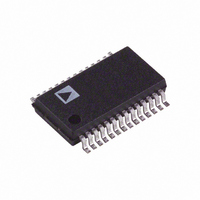AD977CRS Analog Devices Inc, AD977CRS Datasheet - Page 19

AD977CRS
Manufacturer Part Number
AD977CRS
Description
IC ADC 16BIT 100KSPS 28-SSOP
Manufacturer
Analog Devices Inc
Datasheet
1.AD977ARZ.pdf
(24 pages)
Specifications of AD977CRS
Rohs Status
RoHS non-compliant
Number Of Bits
16
Sampling Rate (per Second)
100k
Data Interface
Serial, SPI™
Number Of Converters
1
Power Dissipation (max)
100mW
Voltage Supply Source
Analog and Digital
Operating Temperature
-40°C ~ 85°C
Mounting Type
Surface Mount
Package / Case
28-SSOP (0.200", 5.30mm Width)
For Use With
EVAL-AD977CB - BOARD EVAL FOR AD977EVAL-AD977ACB - BOARD EVAL FOR AD977A
OFFSET AND GAIN ADJUSTMENT
The AD977/AD977A is factory trimmed to minimize gain,
offset and linearity errors. In some applications, where the ana-
log input signal is required to meet the full dynamic range of the
ADC, the gain and offset errors need to be externally trimmed
to zero. Figures 12 and 13 show the required trim circuitry to
correct for these offset and gain errors.
Where adjustment is required, offset error must be corrected
before gain error. To achieve this in the bipolar input configura-
tion, trim the offset potentiometer with the input voltage set to
1/2 LSB below ground. Then adjust the potentiometer until the
major carry transition is located between 1111 1111 1111 1111
and 0000 0000 0000 0000. To adjust the gain error, an analog
signal should be input at either the first code transition (ADC
negative full scale) or the last code transition (ADC positive full
scale). Thus, to adjust for full-scale error, an input voltage of
FS/2 – 3/2 LSBs can be applied to V
eter should be adjusted until the output code flickers between
the last positive code transition 0111 1111 1111 1111 and 0111
1111 1111 1110. Should the first code transition need adjust-
ing, the trim procedure should consist of applying an analog
input signal of –FS/2 + 1/2 LSB to the V
ing the trim until the output code flickers between 1000 0000
0000 0000 and 1000 0000 0000 0001.
AC PERFORMANCE
The AD977/AD977A is fully specified and tested for dynamic
performance specifications. The ac parameters are required for
signal processing applications such as speech recognition and
spectrum analysis. These applications require information on
the ADC’s effect on the spectral content of the input signal.
Hence, the parameters for which the AD977/AD977A is specified
include S/(N+D), THD and Spurious Free Dynamic Range.
These terms are discussed in greater detail in the following
sections.
As a general rule, it is recommended that the results from sev-
eral conversions be averaged to reduce the effects of noise and
thus improve parameters such as S/(N+D) and THD. The ac
performance of the AD977/AD977A can be optimized by operat-
ing the ADC at its maximum sampling rate of 100 kHz/200 kHz
and digitally filtering the resulting bit stream to the desired signal
bandwidth. By distributing noise over a wider frequency range
the noise density in the frequency band of interest can be
reduced. For example, if the required input bandwidth is 50 kHz,
–100
–110
–120
–130
–10
–20
–30
–40
–50
–60
–70
–80
–90
0
0
5
10
15
20
25
30
35
FREQUENCY – kHz
40
45
50
55
IN
60
, and the gain potentiom-
5280 POINT FFT
F
F
SNRD = 86dB
THD = –101dB
65
SAMPLE
IN
= 20kHz, 0dB
70
IN
75
input and adjust-
= 200kHz
80
85
90 95
100
the AD977/AD977A could be oversampled by a factor of 2/4.
This would yield a 3/6 dB improvement in the effective SNR
performance.
DC PERFORMANCE
The factory calibration scheme used for the AD977/AD977A
compensates for bit weight errors that may exist in the capacitor
array. The mismatch in capacitor values is adjusted (using the
calibration coefficients) during a conversion resulting in excel-
lent dc linearity performance. Figures 18, 19, 20, 21, 22 and 23,
respectively, show typical INL, typical DNL, typical positive and
negative INL and DNL distribution plots for the AD977/AD977A
at 25°C.
A histogram test is a statistical method for deriving an A/D
converter’s differential nonlinearity. A ramp input is sampled by
the ADC and a large number of conversions are taken at each
voltage level, averaged then stored. The effect of averaging is to
reduce the transition noise by 1/n. If 64 samples are averaged at
each point, the effect of transition noise is reduced by a factor of
8, i.e., a transition noise of 0.8 LSBs rms is reduced to
0.1 LSBs rms. Theoretically the codes, during a test of DNL,
would all be the same size and therefore have an equal number
of occurrences. A code with an average number of occurrences
would have a DNL of “0.” A code that is different from the
average would have a DNL that was either greater or less than
zero LSB. A DNL of –1 LSB indicates that there is a missing
code present at the 16-bit level and that the ADC exhibits 15-
bit performance.
–0.5
–1.0
–1.5
–2.0
–2.0
–0.5
–1.0
–1.5
2.0
1.5
1.0
0.5
2.0
1.5
1.0
0.5
0
0
0
0
5
5
10
10
15
15
20
20
OUTPUT CODE – K
OUTPUT CODE – K
25
25
30
30
100%
100%
35
35
AD977/AD977A
40
40
45
45
50
50
55
55
60
60
66
66












